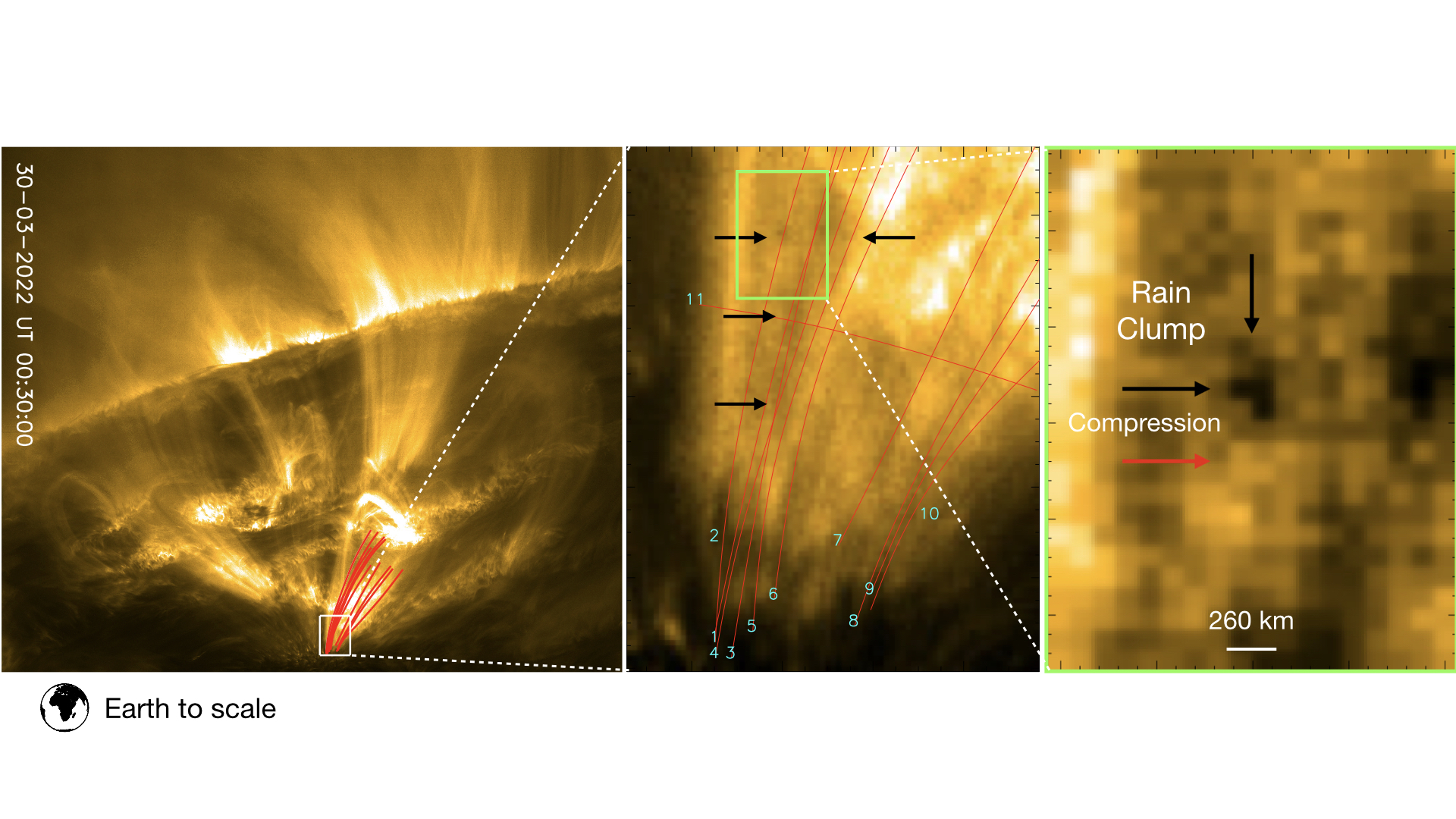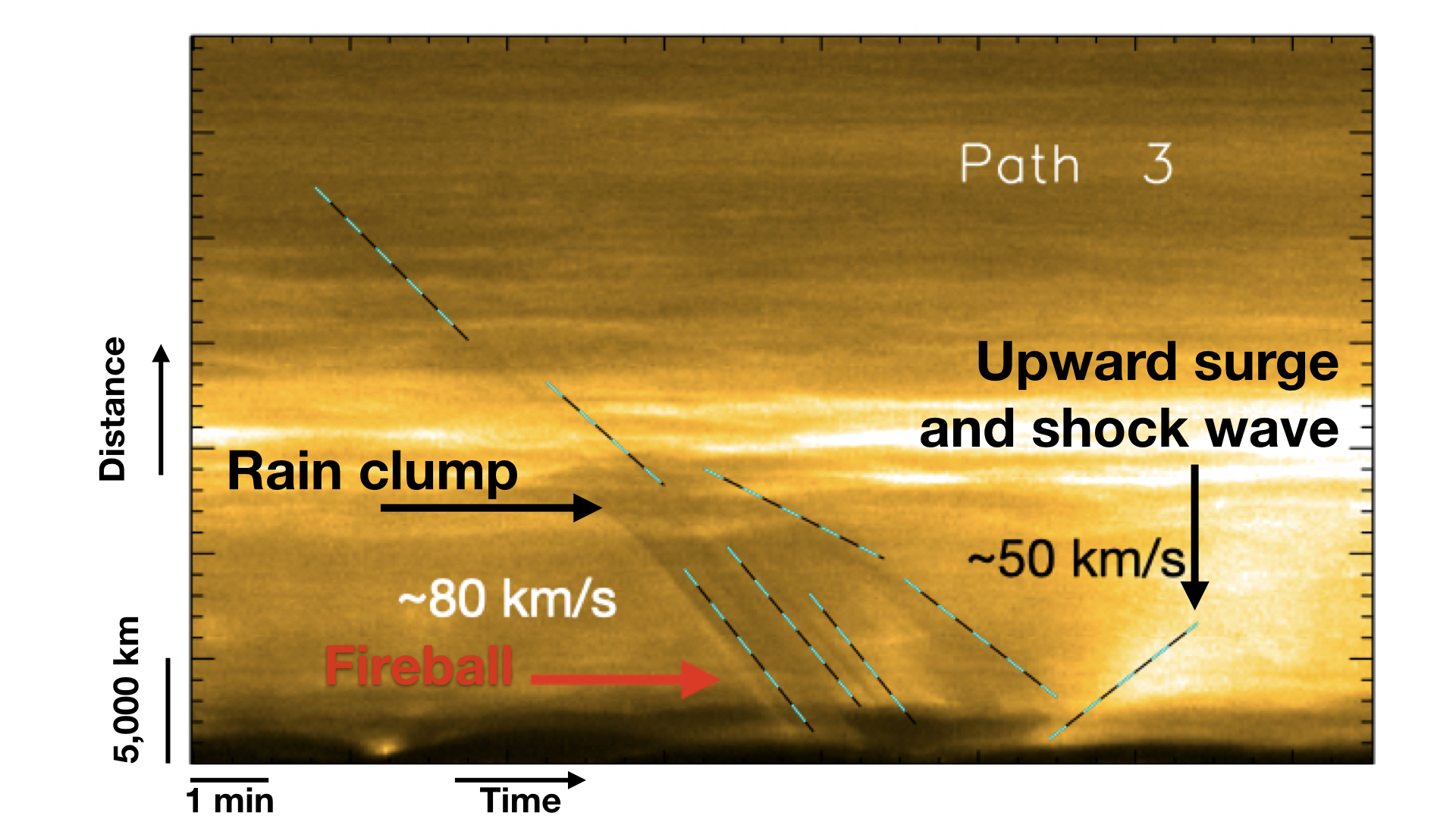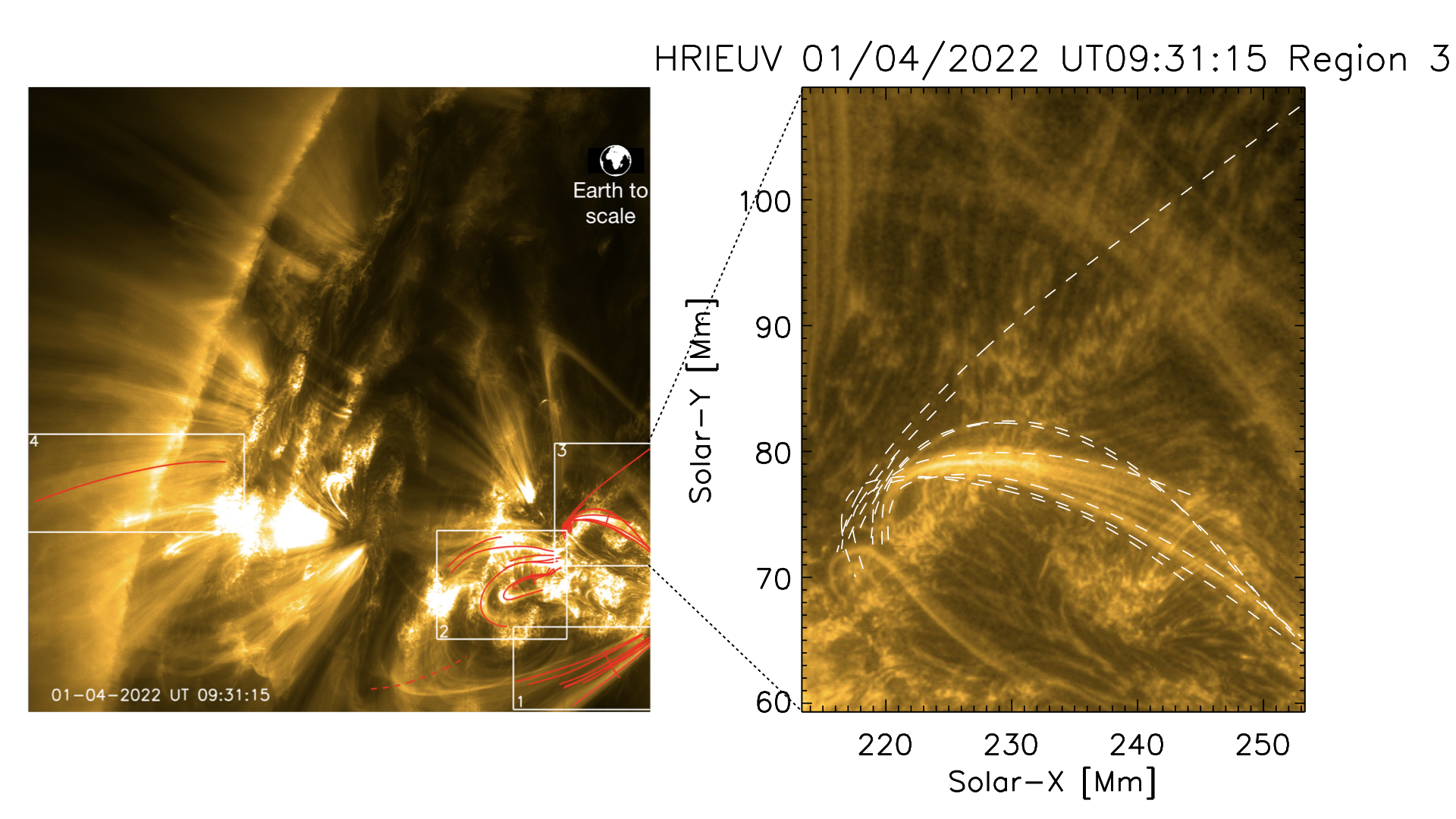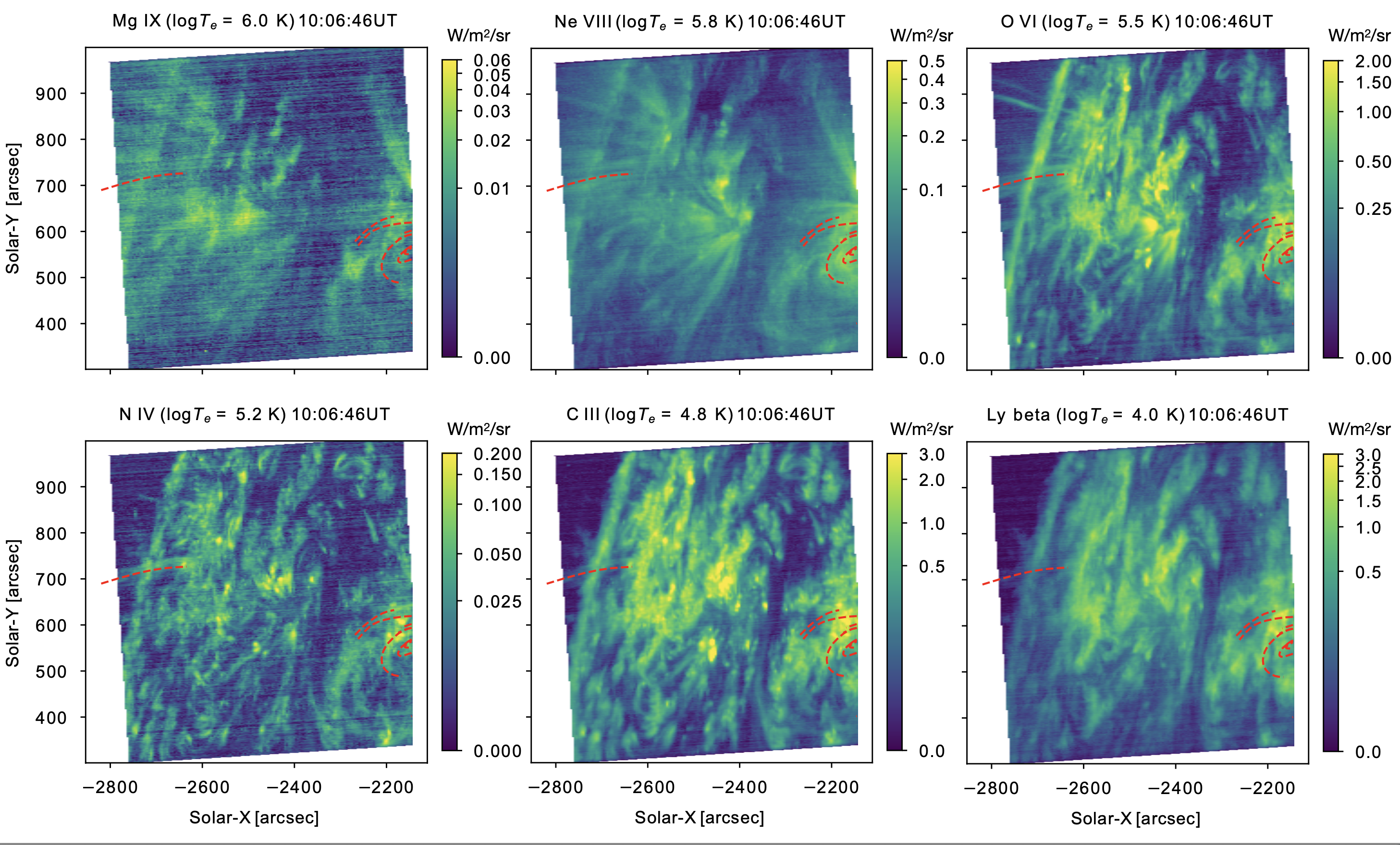Science nugget: A sharp EUI and SPICE look into the EUV variability and fine-scale structure associated with coronal rain - Solar Orbiter
A sharp EUI & SPICE look into the EUV variability and fine-scale structure associated with coronal rain
(Solar Orbiter nugget #14 by P. Antolin1, A. Dolliou2, F. Auchère2, L.P. Chitta3, S. Parenti2, D. Berghmans3 & EUI Team)
Introduction
The solar atmosphere is exceptionally hot, millions of degrees hotter than the underlying surface. However, it can also dramatically cool down due to thermal instability under very specific spatial and temporal conditions of the heating mechanism. For strongly stratified and high-frequency heating (when heating events occur at a rate faster than the radiative cooling time of the coronal structure), the structures become radiatively unstable and undergo cycles of heating (evaporation) and cooling (condensation), also known as TNE-TI (for thermal non-equilibrium - thermal instability) [1, 2]. TI leads to the generation of dense and cool clumpy plasma that falls down towards the solar surface in a process known as coronal rain [3, 4].
Aims & Methods
In this work we use the high-resolution EUI data (with HRIEUV) [5] on Solar Orbiter [6] from the early Spring 2022 perihelion to identify observable features of the TNE-TI scenario. We aim to understand the role TNE-TI plays in the observed EUV variability and morphology of the solar corona.

Figure 1. (Left) HRIEUV field-of-view (FOV) on 2022-03-30 showing an active region on the East limb (figure has been rotated). Coronal rain (red paths) was seen along a coronal loop. (Middle) A zoomed-in portion of the loop footpoint. The rain is seen in EUV absorption (black arrows). (Right) A zoomed-in portion on a rain clump (black arrows), with the bright compression region underneath (red arrows) that produces the fireball effect (see animation).
Small scale features
HRIEUV detects EUV absorption features as small as 260km produced by coronal rain, with a width average of 500 ± 200 km. The rain is observed to fall at speeds in the plane-of-the-sky (POS) of 10-150 km/s, generating in some cases a brightening immediately underneath the clumps as they fall [7]. We interpret this brightening as a result of compression and heating, similar to the fireball effect for meteors (although without ablation)

Figure 2. Time-distance diagram along path 3 (shown in Figure 1) followed by rain clumps. Zero distance corresponds to the chromosphere. The dark features correspond to rain, while the bright features immediately underneath correspond to the fireball (compression an heating). The bright wide feature with positive slope indicates a surge and shock wave propagating upwards.
We also observe the appearance of EUV strands prior/during the rain, having similar widths as the rain, which may be the result of the CCTR (Condensation Corona Transition Region) [8]. Just prior to impact, the entire region beneath the rain is observed to brighten, producing a flash-like EUV event along a few strands. This is only observed for the fastest events, and may be a result of very strong compression.

Figure 3. (Left) HRIEUV FOV on 2022-04-01 showing another active region on the East limb. Coronal rain (red paths) was seen along several coronal structures. Four regions were selected. (Right) A zoom-in on Region 3. Some rain paths are shown in dashed white curves. Note the appearance of multi-stranded structure (see animation).
Large scale features
SPICE [9] detects sequential brightening of loops, from hotter to cooler spectral bands, just prior to the appearance of coronal rain. This matches the cooling expected in the TNE-TI scenario.

Figure 4. Multi-spectral view on a portion of Region 2 shown in Figure 3. The blue-green maps correspond to SPICE rasters on several spectral lines (whose ion is indicated on top of each map, with respective maximum formation temperature). The yellow map corresponds to an HRIEUV synthetic raster, following the SPICE rastering characteristics. The maps are ordered by decreasing temperature from right to left. The red paths in each map correspond to coronal rain paths (as shown also in Figure 3). Three map groups are shown, separated by 16 min (cadence of raster). The red arrow shows a loop that reaches maximum brightness at that specific raster time. Sequential brightening from right (hot) to left (cool) is seen, indicating cooling.
HRI_EUV detects the the impact of rain showers for the first time. We observe an upward propagating EUV perturbance at speeds of 50-130 km/s, which we interpret as a combination of hot flows and slows modes that partially reheat the loop [10].
Observations with AIA 171 [11] on board Solar Dynamics Observatory [12] in quadrature only capture a small fraction of the observed rain events. On the other hand, AIA 304 shows widespread coronal rain, in agreement with SPICE observations that show abundance of cool structures (in the lower and upper transition region lines). This shows that detecting coronal rain in EUV absorption needs high spatial resolution and depends on the line-of-sight as well.

Figure 5. Multi-spectral view of the full FOV of SPICE on 2022-04-01. Each map corresponds to a specific spectral line indicated on top, together with the time of the raster. The red paths show the rain trajectories common to Figure 3. Note the presence of many coronal structures at relatively cool temperatures (lower to upper transition region).
Conclusions
Coronal rain generates EUV structure and variability over a wide range of scales, from coronal loops to the smallest resolvable scales (strand widths, fireballs). This establishes the major role that TNE-TI plays in the observed EUV morphology and variability of the corona.
This study has been published in Antolin, P. et al. A&A in press, doi.org/10.1051/0004-6361/202346016
Acknowledgements:
P.A. acknowledges funding from STFC Ernest Rutherford Fellowship No. ST/R004285/2.
Affiliations:
1Department of Mathematics, Physics and Electrical Engineering, Northumbria University, Newcastle upon Tyne NE1 8ST, UK
2Institut d'Astrophysique Spatiale, Université Paris-Saclay, Orsay, France
3Max Planck Institut for Solar System Research, Göttingen, Germany
4Royal Observatory of Belgium, Brussels, Belgium
References
[1] Antolin, P. & Froment, C., FrASS 9 (2022), doi.org/10.3389/fspas.2022.820116
[2] Klimchuk, J. & Luna, M., ApJ 884, 68 (2019), doi.org/10.3847/1538-4357/ab41f4
[3] Leroy J. L., Sol Phys 25, 413 (1972), dx.doi.org/10.1007/BF00192338
[4] Antolin, P. & Rouppe van der Voort, L., ApJ 745, 152 (2012), dx.doi.org/10.1088/0004-637X/745/2/152
[5] Rochus, P., Auchère, F., Berghmans, D., et al. 2020, A&A, 642, A8 https://doi.org/10.1051/0004-6361/201936663
[6] Müller, D., St. Cyr, O. C., Zouganelis, I., et al. 2020, A&A, 642, A1 https://doi.org/10.1051/0004-6361/202038467
[7] Li, X., Keppens, R. & Zhou, Y. ApJ 926, 216 (2022), doi.org/10.3847/1538-4357/ac41cd
[8] Antolin, P., Martínez-Sykora, J. & Sahin, S., ApJL 926, 29 (2022), doi.org/10.3847/2041-8213/ac51dd
[9] SPICE Consortium (Anderson, M., et al.) 2020, A&A, 642, A14 https://doi.org/10.1051/0004-6361/201935574
[10] Müller, D., Peter, H. & Hansteen, V., A&A 424, 289 (2004), dx.doi.org/10.1051/0004-6361:20040403
[11] Lemen, J. R., Title, A. M., Akin, D. J., et al. 2012, Sol. Phys., 275, 17 DOI 10.1007/s11207-011-9776-8
[12] Pesnell, W. D., Thompson, B. J., & Chamberlin, P. C. 2012, Sol. Phys., 275, 3 DOI 10.1007/s11207-011-9841-3
- Removed a total of (5) style margin:0;
Nuggets archive
2025
09/04/2025: Bursty acceleration and 3D trajectories of electrons in a solar flare
02/04/2025: Picoflare jets in the coronal holes and their link to the solar wind
19/03/2025: Radial dependence of solar energetic particle peak fluxes and fluences
12/03/2025: Analysis of solar eruptions deflecting in the low corona
05/03/2025: Propagation of particles inside a magnetic cloud: Solar Orbiter insights
19/02/2025: Rotation motions and signatures of the Alfvén waves in a fan-spine topology
12/02/2025: 'Sun'day everyday: 2 years of Solar Orbiter science nuggets that shed light on some of our star's mysteries
22/01/2025: Velocity field in the solar granulation from two-vantage points
15/01/2025: First joint X-ray solar microflare observations with NuSTAR and Solar Orbiter/STIX
2024
18/12/2024: Shocks in tandem : Solar Orbiter observes a fully formed forward-reverse shock pair in the inner heliosphere
11/12/2024: High-energy insights from an escaping coronal mass ejection
04/12/2024: Investigation of Venus plasma tail using the Solar Orbiter, Parker Solar Probe and Bepi Colombo flybys
27/11/2024: Testing the Flux Expansion Factor – Solar Wind Speed Relation with Solar Orbiter data
20/11/2024:The role of small scale EUV brightenings in the quiet Sun coronal heating
13/11/2024: Improved Insights from the Suprathermal Ion Spectrograph on Solar Orbiter
30/10/2024: Temporally resolved Type III solar radio bursts in the frequency range 3-13 MHz
23/10/2024: Resolving proton and alpha beams for improved understanding of plasma kinetics: SWA-PAS observations
25/09/2024: All microflares that accelerate electrons to high-energies are rooted in sunspots
25/09/2024: Connecting Solar Orbiter and L1 measurements of mesoscale solar wind structures to their coronal source using the Adapt-WSA model
18/09/2024: Modelling the global structure of a coronal mass ejection observed by Solar Orbiter and Parker Solar Probe
28/08/2024: Coordinated observations with the Swedish 1m Solar Telescope and Solar Orbiter
21/08/2024: Multi-source connectivity drives heliospheric solar wind variability
14/08/2024: Composition Mosaics from March 2022
19/06/2024: Coordinated Coronal and Heliospheric Observations During the 2024 Total Solar Eclipse
22/05/2024: Real time space weather prediction with Solar Orbiter
15/05/2024: Hard X ray and microwave pulsations: a signature of the flare energy release process
01/02/2024: Relativistic electrons accelerated by an interplanetary shock wave
11/01/2024: Modelling Two Consecutive Energetic Storm Particle Events observed by Solar Orbiter
2023
14/12/2023: Understanding STIX hard X-ray source motions using field extrapolations
16/11/2023: EUI data reveal a "steady" mode of coronal heating
09/11/2023: A new solution to the ambiguity problem
02/11/2023: Solar Orbiter and Parker Solar Probe jointly take a step forward in understanding coronal heating
25/10/2023: Observations of mini coronal dimmings caused by small-scale eruptions in the quiet Sun
18/10/2023: Fleeting small-scale surface magnetic fields build the quiet-Sun corona
27/09/2023: Solar Orbiter reveals non-field-aligned solar wind proton beams and its role in wave growth activities
20/09/2023: Polarisation of decayless kink oscillations of solar coronal loops
23/08/2023: A sharp EUI and SPICE look into the EUV variability and fine-scale structure associated with coronal rain
02/08/2023: Solar Flare Hard Xrays from the anchor points of an eruptive filament
28/06/2023: 3He-rich solar energetic particle events observed close to the Sun on Solar Orbiter
14/06/2023: Observational Evidence of S-web Source of Slow Solar Wind
31/05/2023: An interesting interplanetary shock
24/05/2023: High-resolution imaging of coronal mass ejections from SoloHI
17/05/2023: Direct assessment of far-side helioseismology using SO/PHI magnetograms
10/05/2023: Measuring the nascent solar wind outflow velocities via the doppler dimming technique
26/04/2023: Imaging and spectroscopic observations of EUV brightenings using SPICE and EUI on board Solar Orbiter
19/04/2023: Hot X-ray onset observations in solar flares with Solar Orbiter/STIX
12/04/2023: Multi-scale structure and composition of ICME prominence material from the Solar Wind Analyser suite
22/03/2023: Langmuir waves associated with magnetic holes in the solar wind
15/03/2023: Radial dependence of the peak intensity of solar energetic electron events in the inner heliosphere
08/03/2023: New insights about EUV brightenings in the quiet sun corona from the Extreme Ultraviolet Imager








































 Sign in
Sign in
 Science & Technology
Science & Technology